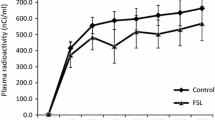Abstract
The immediate and long-term effects of the selective serotonergic neurotoxin 5,7-dihydroxytryp-tamine (5,7-DHT) on rat striatal serotonergic neurons were examined after its intracerebroventricular administration using in vivo voltammetry. Extracellular concentration of 5-hydroxyindoles increased immediately following intracerebroventricular 5,7-DHT injection (200 μg in 24 μl, 18 min), peaked at 1.5-2 h, and returned to normal by 4 h. 5,7-DHT diffused to the contralateral striatum in detectable amounts 9 to 12 min after the start of injection and returned to basal levels by 1.5 h. Three to 6 days after 5,7-DHT lesions, 5-hydroxytryptophan administration produced an increase in striatal 5-hydroxyindoles that was greater than that produced in pre-lesioned rats. This effect was maximal at 14 to 17 days post-lesion, and remained even after 50 days. The short-term effect of 5,7-DHT may be attributable to increased serotonin release, inhibition of uptake, or monoamine oxidase inhibition. The long-term effect of 5,7-DHT lesions may attributable to increased synthesis of serotonin or decreased reuptake in remaining serotonergic neurons.
Similar content being viewed by others
REFERENCES
Handley, S. L., and McBlane, J. W. 1993. 5-HT drugs in animal models of anxiety. Psychopharmacology 112:13-20.
Roberts, D. C. S., Loh, E. A., Baker, G. B., and Vickers, G. 1994. Lesions of central serotonin systems affect responding on a progressive ratio schedule reinforced either by intravenous cocaine or by food. Pharmacol. Biochem. Behav. 49:177-182.
Jankowska, E, Bidzinski, A., and Kostowski, W. 1994. Alcohol drinking in rats treated with 5,7-dihydroxytryptamine: effect of 8-OH-DPAT and Tropisetron (ICS205-930). Alcohol 11:283-288.
Breeze, G. R., and Cooper, B. R. 1975. Behavioral and biochemical interactions of 5,7-dihydroxytryptamine with various drugs when administered intracisternally to adult and developing rats. Brain Res. 98:517-527.
Jonsson G. 1983. Chemical lesioning techniques: monoamine neurotoxins. Pages 463-507, inBjörklund, A. and Hökfelt T. (eds.), Handbook of Chemical Neuroanatomy, Vol. 1, Elsevier, Amsterdam.
Gerson S., and Baldessarini R. J. 1975. Selective destruction of serotonin terminals in rat forebrain by high doses of 5,7-dihydroxytryptamine. Brain Res. 85:140-145.
Björklund, A., Horn, A. S., Baumgarten, H. G., Nobin., A., and Schlossberger, H. G. 1975. Neurotoxicity of hydroxylated tryptamines: structure-activity relationships. 2. In vitrostudies on monoamine uptake inhibition and uptake impairment. Acta Physiol. Scand. Supp. 429:30-60.
Baumgarten, H. G., Lachenmayer, L., and Björklund, A. 1977. Chemical lesioning of indoleamine pathways. Pages 47-97, inMyers, R. D. (eds.), Methods in Psychobiology, Vol. 3, Academic Press, New York.
Kalen, P., Strecker, R. E., Rosengren, E., and Björklund A. 1988. Endogenous release of neuronal serotonin and 5-hydroxyindoleacetic acid in the caudate-putamen of the rat as revealed by intracerebral dialysis coupled to high-performance liquid chromatography with fluorimetric detection. J. Neurochem. 51:1422-1435.
Paxinos, G., and Watson, C. 1982. The Rat Brain in Stereotaxic Coordinates, Academic Press, Sydney.
Nakazato, T., and Akiyama A. 1988. In vivo voltammetric study of 6-hydroxydopamine-induced neuronal degradation. J. Neurochem. 51:1007-1013.
Nakazato, T., and Akiyama, A. 1989. Effect of exogenous L-DOPA on behavior in the rat: an in vivo voltammetric study. Brain Res. 490:332-338.
Nakazato, T., Akiyama, A., and Shimizu A. 1988. Microcomputer-controlled in vivo voltammetry. Biogenic Amines 5:339-350.
Nakazato, T., and Akiyama, A. 1989. Decarboxylation of exogenous L-3,4-dihydroxyphenylalanine in rat striatum as studied by in vivo voltammetry. J. Neurochem. 58:121-127.
Nakazato, T., Hosoda, S., and Akiyama A. 1993. A triangular conditioning voltage wave does not influence spontaneous neuronal activity in the rat striatum. J. Neurosci. Methods 46:69-72.
Baumgarten, H. G., Björklund, A., Nobin, A., Rosengren, E., and Schlossberger, H. G., 1975. Neurotoxicity of hydroxylated tryptamines: structure-activity relationships. 1. Long-term effects on monoamine content and fluorescence morphology of central monoamine neurons. Acta Physiol. Scand. Supp. 429:6-27.
Klemm, H. P., and Baumgarten, H. G. 1978. Interaction of 5,6-and 5,7-dihydroxytryptamine with tissue monoamine oxidase. Ann. N. Y. Acad. Sci. 305:36-56.
Cohen, G., and Heikkila, R. E. 1978. Mechanisms of action of hydroxylated phenylethlyamine neurotoxins. Ann. N. Y. Acad. Sci. 305:74-84.
Gerhardt, G., and Adams, R. N. 1982. Determination of diffusion coefficients by flow injection analysis. Anal. Chem. 54:2618-2620.
Christenson, J. G., Dairman W., and Udenfriend, S. 1972. On the identity of DOPA decarboxylase and 5-hydroxytryptophan decarboxylase. Proc. Natl. Acad. Sci. USA. 69:343-347.
Melamed, M., Hefti, F., and Wurtman R. J. 1980. L-3,4-dihydroxyphenylalanine and L-5-hydroxytryptophan decarboxylase activities in rat striatum: effect of selective destruction of dopaminergic or serotonergic input. J. Neurochem. 34:1753-1756.
Liston, D. R., Franz, D. N., and Gibb J. W. 1982. Biochemical evidence for alteration of neostriatal dopaminergic function by 5,7-dihydroxytryptamine. J. Neurochem. 38:1329-1335.
Sims, K. L., Davis, G. A., and Bloom, F. E. 1973. Activities of 3,4-dihydroxyphenylalanine and 5-hydroxy-L-tryptophan decarboxylases in rat brain: assay characteristics and distribution. J. Neurochem. 20:449-464.
Agid, Y., and Javoy, F., Glowinski, J. 1973. Hyperactivity of remaining dopaminergic-neurones after partial destruction of the nigro-striatal dopaminergic system in the rat. Nature New Biol. 245:150-151.
Björklund, A. and Wilklund, L. 1980. Mechanism of regrowth of the bulbospinal serotonin system following 5,6-dihydroxytryptamine induced axonotomy: 1. biochemical correlates. Brain Res. 191:109-127.
Fuller R. W. 1994. Uptake inhibitors increase extracellular serotonin concentration measured by brain microdialysis. Life Sci. 55:163-167.
Author information
Authors and Affiliations
Rights and permissions
About this article
Cite this article
Nakazato, T., Akiyama, A. Immediate and Long-Term Effects of 5,7-Dihydroxytryptamine on Rat Striatal Serotonergic Neurons Measured Using In Vivo Voltammetry. Neurochem Res 23, 1–6 (1998). https://doi.org/10.1023/A:1022460216822
Issue Date:
DOI: https://doi.org/10.1023/A:1022460216822




